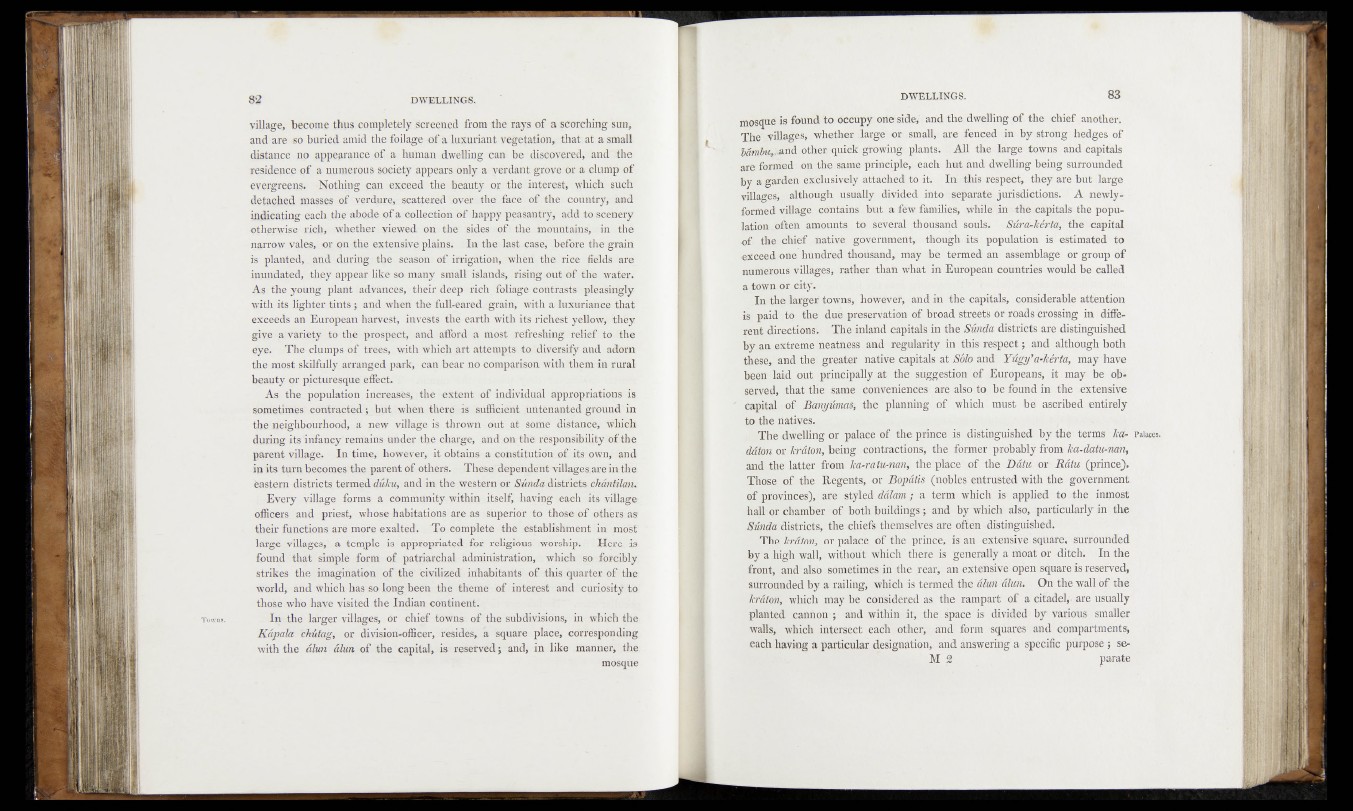
village, become thus completely screened from .the rays of a scotching sun,
and are so buried amid the foilage of a luxuriant yegetation, that at a small
distance no appearance of a human dwelling can be discovered, an.d'Tthei
residence .of a numerous society appears only a verdant grove or a clump of
evergreens. Nothing pan exceed the beauty or the interest, which such
detaefeed masses of verdure, scattered over the face of the country, and
indicating each..the abode .of a collection of happy peasantry, add to.scenery
otherwise rich, whether viewed on the tides :of - the mountains, tin. the
narrow vales, or on the extensive plains. In the last case, before the grain
is planted, and during the season of irrigation, when, the rice fields are
inundated, they appear like so many small islands, rising out- of the water.
As the young plant advances, their deep- rich foliage contrasts pleasingly
with its lighter tints; and when the full-eared, grain, with a luxuriance that
exceeds an European harvest, invests the earth with its richest yellow, they
give a variety to the prospect, and afford a most refreshing relief: to ithe
eye. The clumps of trees, with which art attempts to diversify and adorn
the most skilfully arranged park, can bear no comparison with them in rural
beauty or picturesque effect.
As the_population increases,, the j extent of individual appropriations is
sometimes contracted; but whew there is sufficient untenanted ground, in
the neighbourhood, a new village is thrown out at same distance, which,
during its infancy remains under the charge, and on the responsibility of the
parent village. In time, however, it obtains a constiliitiomof its own, and
in its turn becomes the. parent of others. These dependent villagesare in the
eastern districts termed dyka, and in the western or districts chdntilan.
. Every--village forms a community within itself, having oeaoh its village»
officers and priest, whose habitations are as superior to those.of others'as
their functions are more exalted. To complete the establishment in most'
large villages, a temple is appropriated for religious worship.. ' Here is
found that simple form of patriarchal administration, which so. forcibly
strikes the imagination of the civilized inhabitants of this quarter of the
world; and which has so long been the theme’ of interest and curiosity to
those who have visited the Indian continent.
In the larger villages, or chief towns of the subdivisions, in which the.
K&pala ‘cküfag, or divisiomofficer, resides, a square place, corresponding
with the dlun dlun of the capital, is reserved ; and, in like manner, the.
mosque
mosque is found 'to occupy one side; and the dwelling of the chief another.
The .villages, whether darge,_ofjsmall-, are fended’ in by strong hedges of
ofbemquick growingi plantswuAll the-- large towns and capitals
are formed, on the same principlfe,;-«each ;hut and dwelling being surrounded
by a- garden exclusively atfeachedlto it. In this respect, they are but large
villages», although usually div^idedi into .separate jurisdictions. A newly* -
formed- village, contains but a fewi families, ’»while' in ‘ the capitals the population
Jaften amounts to; Several-thousand souls? ^Sdra^Mrtd,''the capital
^f. the. chief native government, -thought Its .'population is estimated to
exceed one hundred thousand,: may be termed, an assemblage or group of
numerous villages, rather than what in European Countries would be called
a town of <59j^yy •
In the larger .towns, hoWever, and,icr the capitals, considerable attention
is- paid' to. the- du'e preservation of' broad "street’s .or roads crossing in diffe-
rent'djrectidnsi Tha-inland capitals in the Snnda districtsare distinguished
by an£kstj§melneatn,ess and regularity in this respect; and although'both
theseV end the greater native capitals at Sob and' Ywgy’a^JcerM, may have
bfeen-laid out-principally ait- the suggestion.’of.Europeans,. it may*; he observed,
that the same conveniences are also to be found’ in the extensive
capital-of Bany’m m , the planning oTwhicff must be ascribed' entirely
to the natives..
, The dwelling or palace of the prince is. ditiinguished':by the terms led- Palaces.
ddton or ^a&mfffeing1 (.contractions; the former ,'prob'ahly from ka-datu-nan,
and the latter from Jca-ddtu-nan, thaVplabe' p fth e Data or- Rata (prince)»,
Those o&thhii Regents, or JBopdtis (nobles;'entrusted with the government
of provinces), !&re' styled ddlam ; a term* which is'applied to ^th’e inmost
hall1'on chamber of both.buildihgs ; and by which; dsQffparticularly in the
Sunda • districts, the chiefsffbfemselves ,afe offen- distinguished*
The %rdton,jOT palace ‘of ,the prince, is an extensive,’ surrounded
by a high wall, without which there is generally anSoat or:»dif!0te!. >Tn the
front, and alsb sometimes in the rear, an extensive open squareis reserved,
surrounded*!)* a railing, which is termed-the dlun dlun. Off the wallof'the
hrdtori, which maybe considered as. the rampart of a citadel^--are usually'
planted cannon ;• and within it, .the space is divided1 by- various- smaller
walls, which intersect each other, and' form -squares;-and. compartments,
each having a particular designation, and answering a specific purpose ; se-
M & ■ , parade ■